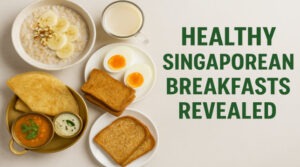In a city where breakfast means kaya toast, kopi, and hawker classics, it’s easy to start the day with comfort—but not always with balance. Singaporeans are busier, more health-conscious, and increasingly aware that what they eat first thing in the morning sets the tone for the day. So what are the healthiest breakfast items for Singaporeans, based on modern nutrition science?

Why breakfast matters more than ever in Singapore
In 2023, Singapore’s Health Promotion Board (HPB) emphasized the role of balanced, lower-sugar, high-fiber breakfasts in reducing obesity, diabetes, and cardiovascular risk. About 1 in 3 adults in Singapore are at risk of developing diabetes, much of it linked to refined carbohydrates and sweetened beverages.
A well-balanced breakfast for Singaporeans should include:
- Complex carbohydrates (whole grains, oats, or brown rice)
- Lean proteins (eggs, tofu, soy milk, or fish)
- Healthy fats (nuts, avocado, olive oil)
- Fiber (vegetables, fruits, legumes)
- Minimal added sugar and salt
Top Healthiest Breakfast Items for Singaporeans
1. Soft-Boiled Eggs with Whole-Grain or Multigrain Toast
- Why it’s good: Eggs are rich in high-quality protein and choline, which support brain function and satiety. Swapping white bread for whole-grain helps stabilize blood sugar and supports digestive health.
- How to make it healthier: Skip butter or margarine; use avocado or nut butter instead.
- Fun fact: Singapore’s HPB “Healthier Choice” logo marks multigrain breads with lower sodium and higher fiber.
2. Oatmeal with Fresh Fruit and Nuts
- Why it’s good: Oats provide beta-glucan fiber, which helps reduce cholesterol. Adding fruits (banana, apple, berries) and nuts improves antioxidants and micronutrients.
- Science-backed: Regular oat intake improves glycemic control and lowers LDL cholesterol.
- Smart tip: Replace condensed milk or syrup with a splash of low-fat milk or unsweetened soy milk.
3. Yong Tau Foo (Choose Smartly!)
- Why it’s good: High in protein and fiber from tofu and vegetables. If prepared right, it’s a low-fat, high-protein option.
- Make it healthier: Pick clear soup over curry or laksa broth; choose boiled or steamed items instead of deep-fried.
- HPB tip: Limit sodium intake by tasting before adding sauces or chili.
4. Chee Cheong Fun (Steamed Rice Rolls) with Light Sauce
- Why it’s good: Steamed, not fried, and gluten-free.
- Make it healthier: Skip the sweet black sauce; use sesame seeds and a little soy sauce instead. Add steamed vegetables or tofu for more nutrition.
- Bonus: Rice rolls made with brown rice flour are increasingly available at health-conscious stalls.
5. Thosai (Dosa) with Sambar and Coconut Chutney
- Why it’s good: A South Indian staple rich in protein and probiotics from fermentation. Sambar provides plant-based protein and antioxidants from lentils and vegetables.
- Smart tip: Choose plain or ragi (finger millet) thosai over ghee or masala versions for fewer calories and more fiber.
- Research: Fermented foods like dosa batters improve gut microbiota and digestion.
6. Whole-Grain Bee Hoon or Brown Rice Porridge
- Why it’s good: Whole-grain bee hoon and brown rice provide more fiber and B vitamins than white rice or noodles.
- How to boost it: Add lean protein (tofu, chicken breast, or ikan bilis) and plenty of vegetables. Avoid high-sodium sauces.
7. Soy Milk and Whole-Wheat Sandwich (Vegetarian Option)
- Why it’s good: Soy milk contains isoflavones and plant-based protein beneficial for heart health. Whole-wheat sandwiches with egg, tuna, or tofu make balanced, portable breakfasts.
- Smart tip: Choose unsweetened soy milk (HPB-approved) and limit spreads like kaya or chocolate.
8. Chia Seed Pudding or Overnight Oats
- Why it’s good: Excellent source of omega-3 fats, plant protein, and fiber. Great for busy mornings.
- How to prepare: Soak chia seeds in low-fat milk or soy milk overnight. Top with fruit or cinnamon for flavor.
What to Limit or Avoid
- Kaya toast with condensed milk coffee: Delicious, but high in sugar and saturated fat. Choose whole-grain bread, less kaya, and unsweetened kopi instead.
- Fried noodles / roti prata / char kway teow: High in refined carbs and oil — enjoy occasionally, not daily.
- Sweetened drinks: Replace with unsweetened kopi-O kosong, green tea, or water.
Verdict
Singaporeans don’t need to abandon tradition for health — just rethink preparation and balance. Swap refined carbs for whole grains, fried foods for steamed ones, and sugary drinks for unsweetened versions. Whether it’s oatmeal, thosai, or yong tau foo, every meal can become a step toward better long-term wellness.
Leave a Reply